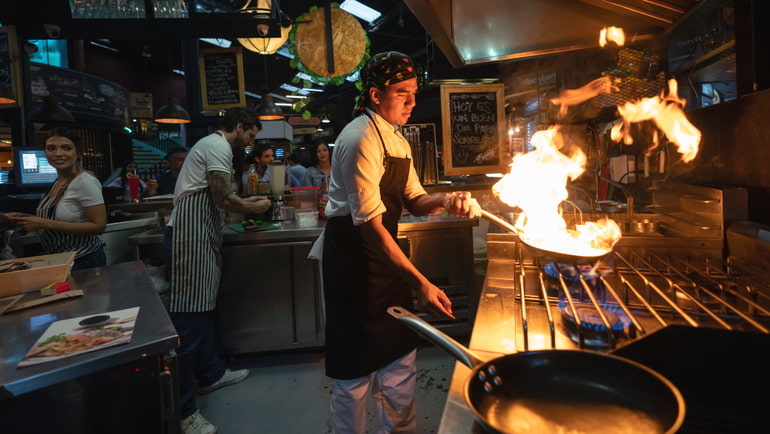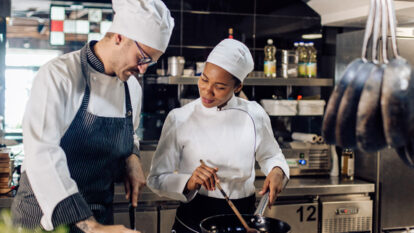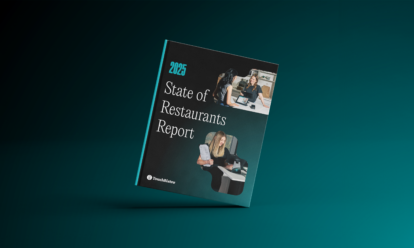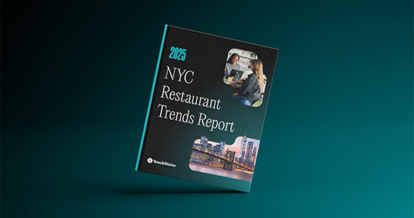When the dining room is full and your kitchen is buzzing, miscommunications about handwritten tickets or verbal orders are the last things your staff should have to worry about. A kitchen display system (KDS) – and more specifically, one with a KDS bump bar – can help you improve accuracy, increase efficiency, and time meals and courses perfectly. This means no more food dying on the pass, and happier diners!
A critical piece of restaurant tech, a kitchen display system replaces old school methods of communicating orders. Instead of scribbling them down or shouting them out, when a server inputs an order into your point of sale system, the KDS routes that order to the right station in your kitchen. The order automatically appears on-screen in the kitchen, and your line cooks can get to work preparing the meal.
While a KDS alone is a powerful tool for streamlining your kitchen operations, you can add extra flexibility by combining it with another piece of tech known as a kitchen or KDS bump bar.
In this guide to KDS bump bars, we’ll cover:
- What a bump bar is, plus its key features
- Why restaurants should use a kitchen bump bar
- The five biggest benefits a bump bar can offer you
Here’s to the next evolution of your kitchen!
What is a Bump Bar?
Depending on the type of kitchen order system you opt for, think of the bump bar like its copilot. If you choose to go with a larger, non-touch kitchen display screen, a bump bar will help you immensely when it comes to landing the plane in the right way at the right time (i.e., getting accurate orders to their final destination of the dining room, quickly).
So, what is a bump bar? It’s a small, programmable device that allows your kitchen staff to easily view which orders are in the queue to be prepared next. A bump bar works with your KDS and enables line cooks to seamlessly navigate kitchen display screens by acting as a remote control.
Features of a Bump Bar
Kitchen bump bar features differ by manufacturer, but here are a few essential features to look out for when shopping for a bump bar.
1. Durable, Programmable Keypad
Things can get messy in the kitchen, so you’ll want a bump bar with a keypad that’s covered in durable plastic. The keypad should also be programmable and user-friendly. This way, you can easily customize its layout based on factors like key locations, key dimensions, and desired number of keys, without having to be a tech whiz to do so!
2. Cross-Screen Communication
Your KDS bump bar should give your kitchen staff the ability to bump orders from one KDS screen to the next in line. This feature comes in handy when an order ticket is finished or if an order is voided. Simply bump it off the screen and move on to the next order. Or, if your kitchen workflow requires cooks on multiple stations to prepare a meal, they can use this feature to bump orders from their station to another.
3. Order Recall
Kitchens are fast-paced environments, and human error is bound to occur at times. This is why you’ll want a bump bar that allows you to recall orders that were accidentally bumped off the screen. It’s also a good idea to make it a habit to view the closed tickets in the system to make sure they don’t contain any accidental “bumps.”

Why Should Restaurants Use a KDS Bump Bar?
Restaurant technology exists to make your life easier. A bump bar does this by allowing kitchen staff to navigate through order tickets without touching the KDS screen. This can be especially useful if employees are wearing gloves or if their hands are wet – both of which are common occurrences in the kitchen that make operating a touchscreen tricky.
If you don’t already have a KDS, you’ll want to consider bump bar compatibility when evaluating different solutions. A good KDS should always be bump bar compatible so that you have the option to use the device if you need it. A solution like TouchBistro’s Kitchen Display System Powered by Fresh helps to keep your order queue organized and your KDS screen clean by using a bump bar to update orders in real time.
Benefits of Using a Bump Bar
Here’s the bottom line: a bump bar helps you improve kitchen efficiency and ensure that orders are fulfilled on time, every time. Here are five ways this device does exactly that.
1. Improves Speed of Service
A lot has changed in the restaurant industry over the past few years, but one thing remains the same: diners don’t like to wait too long for their food. In fact, 57% of diners surveyed for TouchBistro’s Diner Trends Report said that speed of service was one of the most important factors of a great dine-in experience.
The problem is, when you don’t have an easy way to track how long tickets have been open, or if you’re waiting for servers to relay every order to line cooks, your kitchen staff can quickly get trapped in the weeds. This can cause an otherwise good service to grind to a halt and leave guests waiting for their food in frustration.
A KDS bump bar helps your kitchen staff move orders along faster, since there’s no need to fumble with paper tickets or slippery touchscreens. And time saved in the kitchen equals faster guest service. It’s as simple as that!
2. Reduces Order Errors
Just like diners don’t like to wait, they also generally don’t enjoy receiving the wrong order. If you’ve been in the restaurant business for a while, you know that handwritten or misprinted chits can lead to frequent order errors, which can damage your reputation over time.
Using a kitchen bump bar minimizes errors like this (or in the best case scenario, eliminates them entirely). It also reduces errors that may result from kitchen staff using wet or sticky hands to operate a touchscreen. Not only does this put a feather in your cap when it comes to customer service, it also cuts down on food waste that occurs when the wrong order gets made.
3. Keeps Back of House Staff Organized
The modern restaurant kitchen is complex. Line cooks are rushing to prepare orders from guests in the dining room, your online ordering system, and potentially a multitude of third-party ordering websites. This is one reason why it’s critical to stay organized.
Another reason? An organized kitchen is a clean and productive kitchen – the kind that consistently dishes out high-quality food with an attractive presentation. A KDS bump bar can help you achieve this reality in your kitchen, regardless of your commercial kitchen layout.
When you use a bump bar to update orders in real time, your staff no longer have to struggle to keep the queue updated. Assembly line production becomes as simple as bumping the order to the next screen. And a more organized queue equals a more efficient team.
4. Enhances the Customer Experience
Knowing that diners value getting their food quickly, it’s easy to see why shorter wait times lead to happier guests. This is crucial, considering that customer service is among the top three factors people care about when dining out – cited by 64% of respondents to our Diner Trends Report, and surpassed only by food quality and restaurant location.
As a savvy restaurateur, you also know that keeping back of house operations running smoothly makes for a better customer experience in the front of house. For this reason alone, investing in a KDS bump bar to make your employees’ jobs easier in the kitchen is a smart move.
5. Protects Restaurant Tech from Damage
Profit margins are tight in the restaurant industry. TouchBistro’s State of Restaurants Report revealed that while sales have remained relatively steady lately, profit margins fell from 12% in 2019 to just 9.8% in 2024 due to the increasing costs of running a restaurant. This means most restaurateurs can’t afford to spend money on tech, only to have it damaged.
Using a touchscreen with wet or sticky hands can lead to wear and tear on the screen, or even having to replace the tech well before you initially intended to. In contrast, a bump bar is more robust and can stand up to the demands of a kitchen environment. It’s also easier to clean, which will save your staff time so they can focus on making great food.
You now have an answer to the question, “What is a bump bar?”. We’ve also shared some key features of a KDS bump bar, plus five major advantages this tech can offer your restaurant. You’re all set to deliver the speed and quality your guests expect, no matter what’s cooking.
Get the Complete Guide to Restaurant Reservations
Sign up for our free weekly TouchBistro Newsletter







